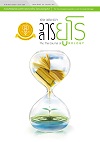Relationship in Pelvimetry and Robotic-assisted Laparoscopic Radical Prostatectomy
Keywords:
pelvimetry, robotic-assisted laparoscopic radical prostatectomy, ความกว้างของอุ้งเชิงกราน, การผ่าตัดมะเร็งต่อมลูกหมากด้วยหุ่นยนต์Abstract
Objective: To measure the correlation of the bony pelvis parameters and the difficulty of RALP in operative time and estimated blood loss (EBL).
Material and Methods: In a retrospective descriptive analytic study from January 2007 to December 2012, 154 cases of prostate cancer patients who underwent RALP by a single surgeon were reviewed, after the exclusion of the first 50 cases. Preoperative data and imaging studies were collected. Bony pelvis measurements, operative time, and EBL were analyzed in order to determine if there is any correlation between them.
Results: There was no significant correlation between pelvic parameters, operative time and EBL. After we analyzed prostate volume and tumor stage, it was determined that they were not correlated. BMI came close to showing a significant correlation with operative time (p-value = 0.009) but not EBL. The nerve-sparing procedure was the only independent parameter that impacted operative time and EBL statistically; however, this finding was not clinically significant because operative times were 157 minutes and 172 minutes in non-nerve sparing and nerve sparing, respectively. And EBL were 200 and 250 ml, respectively.
Conclusion: Bony pelvis parameters did not affect surgical difficulty in this study. Only the nerve sparing procedure was related to operative time and EBL. For experienced surgeons there was no clinical significance in performing non-nerve sparing and nerve-sparing RALP in selected patients.
ความสัมพันธ์ระหว่างความกว้างของอุ้งเชิงกรานและการผ่าตัดมะเร็งต่อมลูกหมากด้วยหุ่นยนต์
ธนบดี ชำนาญสงเคราะห์, ภควัฒน์ ระมาตร์, สุนัย ลีวันแสงทอง, ไชยยงค์ นวลยง
สาขาวิชาศัลยศาสตร์ยูโรวิทยา ภาควิชาศัลยศาสตร์ คณะแพทยศาสตร์ศิริราชพยาบาล มหาวิทยาลัยมหิดล
บทคัดย่อ
วัตถุประสงค์: เพื่อแสดงความสัมพันธ์ของกระดูกอุ้งเชิงกรานกับเวลาที่ใช้ในการผ่าตัดและปริมาณเลือดที่สูญเสียระหว่างการผ่าตัด
ผู้ป่วยและวิธีการศึกษา: ศึกษาวิจัยย้อนหลัง โดยรวบรวมข้อมูลจากผู้ป่วย 154 รายที่ได้รับการผ่าตัดมะเร็งต่อมลูกหมากโดยใช้หุ่นยนต์ช่วยโดยศัลยแพทย์คนเดียว ซึ่งได้ตัด 50 รายแรกออกไป ข้อมูลของผู้ป่วยและภาพถ่ายทางรังสีวิทยาของอุ้งเชิงกรานได้นำมาวิเคราะห์หาความสัมพันธ์กับเวลาที่ใช้ในการผ่าตัดและปริมาณเลือดที่สูญเสียระหว่างการผ่าตัด
ผลการศึกษา: ค่าความกว้างของอุ้งเชิงกรานไม่มีความสัมพันธ์กับเวลาที่ใช้ในการผ่าตัดและปริมาณเลือดที่สูญเสียระหว่างการผ่าตัด และไม่พบความสัมพันธ์ของปริมาตรต่อมลูกหมาก และระยะของมะเร็งต่อมลูกหมาก ผลการศึกษา พบว่าค่าดัชนีมวลกายมีความสัมพันธ์ทางสถิติกับระยะเวลาที่ใช้ในการผ่าตัด (p-value = 0.009) โดยการผ่าตัดแบบเก็บเส้นประสาทเป็นปัจจัยที่มีผลมากที่สุด โดยเวลาผ่าตัดเฉลี่ยที่ใช้ในกลุ่มที่ไม่ได้เก็บเส้นประสาทเท่ากับ 157 นาที และในกลุ่มที่เก็บเส้นประสาทเท่ากับ 172 นาที ส่วนปริมาณเลือดที่สูญเสียระหว่างผ่าตัดเท่ากับ 200 มิลลิลิตรในกลุ่มที่ไม่ได้เก็บเส้นประสาทและ 250 มิลลิลิตรในกลุ่มที่ได้เก็บเส้นประสาท
สรุป: ความกว้างของอุ้งเชิงกรานไม่มีผลต่อความยากง่ายในการผ่าตัดมะเร็งต่อมลูกหมากโดยใช้หุ่นยนต์ช่วย มีเพียงการเก็บเส้นประสาทเท่านั้นที่มีผลต่อเวลาที่ใช้ในการผ่าตัดและปริมาณเลือดที่สูญเสียระหว่างผ่าตัด ซึ่งปัจจัยที่สำคัญที่สุดน่าจะเป็นประสบการณ์การผ่าตัดของศัลยแพทย์ โดยการผ่าตัดแบบเก็บเส้นประสาทไม่มีผลต่อเวลาที่ใช้ในการผ่าตัดและปริมาณเลือดที่สูญเสียระหว่างผ่าตัด เมื่อมีการคัดเลือกผู้ป่วยที่เหมาะสม



